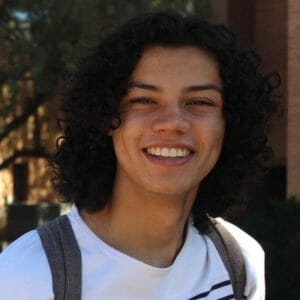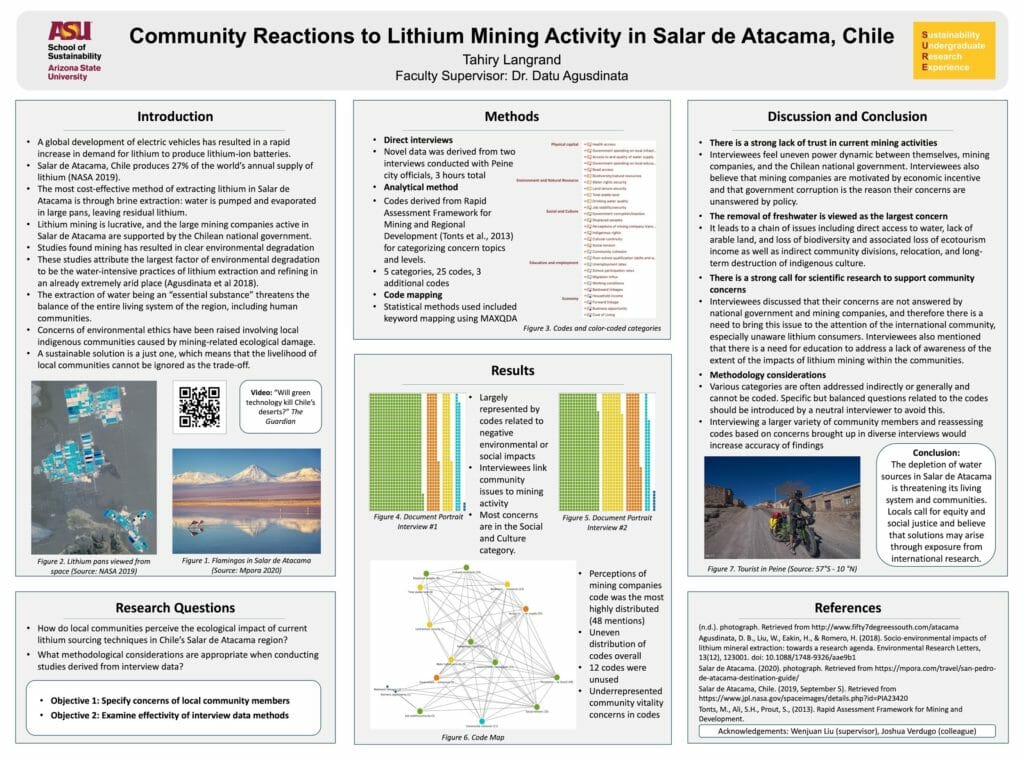The Student Undergraduate Research Experience (SURE) is an opportunity for undergraduate students to find a research fellow and gain substantive research on a faculty-supervised project. This year, School of Sustainability student Tahiry Langrand participated in a project on lithium mining with Datu Agusdinata.
“I was driven to work with Dr. Agusdinata on his research on the community impacts of lithium mining in Salar de Atacama because I was especially interested in the ethical considerations of natural resource extraction,” Langrand said. Read more from Langrand in his Q&A.
Sustainability Connect Question (SC): Can you tell us a little bit about your passions in sustainability and conservation?
Tahiry Langrand (TL): I am passionate in helping mitigate global biodiversity loss and associated human suffering through collaborative conservation efforts. I intend to work on these solutions in biodiversity hotspots through a perspective that embodies the idea of humans functioning as a part of the environment. I decided to pursue sustainability as an undergraduate degree to gain knowledge of both human and natural systems and expose me to a multi and trans-disciplinary mentality, a vital outlook on how to solve global issues.
SC: What drove you to this specific SURE program research project?
TL: I was driven to work with Dr. Agusdinata on his research on the community impacts of lithium mining in Salar de Atacama because I was especially interested in the ethical considerations of natural resource extraction. I wanted to help uncover the complex sustainability considerations of a growing “green movement” of replacing the gasoline vehicle industry with electric vehicles and explore solutions for better lithium sourcing methods. I was also interested in the ecological impact of the mining, which not only disrupted local wildlife but people and traditions.
SC: As an undergraduate research assistant, what is your role and what does it entail?
TL: As a research assistant, I worked closely with doctoral student Wenjuan Liu and my colleague Joshua Verdugo, helping to examine the socio-economic impacts caused by environmental degradation from lithium mining activity as well as the perception and demands of tourists. This consisted of transcribing interviews in Spanish between researchers and local officials on MAXQDA2020 software. From the transcriptions, I coded keywords derived from the Rapid Assessment Framework for Mining and Regional Development for categorizing concern topics and levels and suggested new concern topics based on the interviews. Then, I mapped the keywords in various graphs and established conclusions setting a direction or scope for future research efforts. Examining the tourist perception of lithium mining/environmental degradation consisted of reviewing forums such as TripAdvisor.
SC: What are some of the socio-economic impacts of lithium mining and how does the research attempt to resolve these disparities?
TL: Global demand for lithium-ion batteries has increased demand for lithium in Salar de Atacama, where 27% of the world’s annual supply is extracted. The most cost-effective method of extracting it is through brine extraction, where water is pumped and evaporated in large pans, leaving behind residual lithium. This practice is extremely water-intensive in an already arid location, and lithium mining is attributed to be the current largest factor of environmental degradation in the region. The removal of water threatens the balance of the entire living system and has resulted in a loss of access to drinking water, the relocation and displacement of people, a loss of ecotourism income, community division, and the long-term destruction of indigenous culture and traditions.
Interviewees expressed that their concerns are not answered by the national government or mining companies, so they feel the need to bring this issue to the attention of the international community, especially to lithium consumers unaware of the externalities of their good intentions. Research can help resolve these disparities by shedding light on the issues, the inequalities, and the reactions of the people directly affected by worldwide lithium consumption.
SC: From a sustainability perspective, how can we think about mining holistically so that all stakeholders benefit?
TL: Sustainability does not only consider efficiency, meaning that despite current lithium sourcing methods in Salar de Atacama being the most cost-effective to help accelerate a global “green” energy transition, the local impact must be considered. Essentially, accepting the externality of others’ suffering is unethical. However, this issue is a ‘wicked’ problem because lithium mining operations create job opportunities and contribute to the Chilean gross domestic product.
In order for all stakeholders to benefit, mining activities should be equitable and the people whose livelihoods are affected should be given a voice. This may be done through representation in the mining corporations or through public policy meant to represent the interests of the people democratically. Other solutions can be found through reducing unnecessary consumption (from the consumer mindset to producing durable products) creating new methods of extraction, or more efficient technologies to mitigate the impact. There is no ‘silver bullet’, but dynamically addressing and putting importance on equity and just representation will lead to better solutions.
SC: What are some of the implications on wildlife and ecosystems and how can this be mitigated?
TL: Like I mentioned, the removal of water for lithium threatens the balance of the entire living system. Environmental degradation was the first contingency of lithium mining to be studied in the region. Biodiversity indicators including keystone species were assessed and it was found that freshwater removal from Andean hypersaline lakes is potentially detrimental and can have irreversible effects on biodiversity and ecosystem dynamics. Some species such as the Andean Flamingo are vulnerable. Mitigation strategies include science-based decision making and the same ethical considerations as for socio-economic impacts for governmental, local, and mining organizations.
SC: What are your biggest learning outcomes?
TL: My biggest learning outcome was realizing the value of qualitative data and not undermining it in research, even though it can be a challenge to portray in an academically acceptable way. The data I worked with consisted mostly of spoken words, which I found to be more important in this environmental justice case especially when quantitative data existed on environmental degradation. This was especially relevant since the purpose of my research was to raise awareness of this issue, a direct answer to the demands of community leaders in Salar de Atacama.

